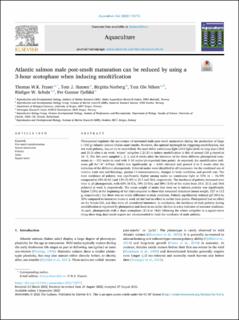| dc.description.abstract | Photoperiod regulates the occurrence of unwanted male post-smolt maturation during the production of large (>100 g) Atlantic salmon (Salmo salar) smolts. However, the optimal daylength for triggering smoltification, but not male puberty, has yet to be established. We used either continuous light (24:0 light/dark) or long days (18:6 and 21:3) after a six week “winter” zeitgeber (12:12) to induce smoltification in fish of around 120 g reared at 16 °C. The fish were sampled 1, 2, 3, and 6 weeks after the initiation of the three different photoperiod treatments (n = 153 males in total with 9–18 males/photoperiod/time point). As expected, the smoltification indicator gill Na+/K+-ATPase (NKA) was significantly (p < 0.05) elevated and peaked 2 to 3 weeks after the initiation of the different photoperiods. Pubertal males were identified in all treatments via the combined use of relative testis size and histology, plasma 11-ketotestosterone, changes in body condition, and growth rate. The total incidence of puberty was significantly higher among males on continuous light at 33% (n = 16/49) compared to 10% (6/61) and 12% (5/43) in 21:3 and 18:6, respectively. The incidence of puberty increased over time in all photoperiods, with 62% (8/13), 19% (3/16), and 38% (3/8) of the males from 24:0, 21:3, and 18:6 pubertal at week 6, respectively. The mean weight of males that went on to initiate puberty was significantly higher (13%) at the beginning of the trial compared to those that remained immature (mean weight, 127 vs 112 g, respectively), but there was no initial difference in body condition. Puberty significantly reduced gill NKA by 35% compared to immature males at week six but had no effect at earlier time-points. Photoperiod had no effect on the female GSI, and they were all considered immature. In conclusion, the incidence of male puberty during smoltification is regulated by photoperiod and leads to an earlier decline in a key indicator of seawater readiness. As such, photoperiods with a short scotophase (21:3 or 18:6) following the winter zeitgeber in a square-wave (long-short-long day) smolt regime are recommended to limit the incidence of male puberty. | en_US |

